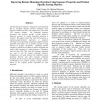Free Online Productivity Tools
i2Speak
i2Symbol
i2OCR
iTex2Img
iWeb2Print
iWeb2Shot
i2Type
iPdf2Split
iPdf2Merge
i2Bopomofo
i2Arabic
i2Style
i2Image
i2PDF
iLatex2Rtf
Sci2ools
BIOCOMP
2009
2009
Improving Remote Homology Detection Using Sequence Properties and Position Specific Scoring Matrices
Current biological sequence comparison tools frequently fail to recognize matches between homologs when sequence similarity is below the twilight zone of less than 25% sequence identity. By combining sequence properties and position specific scoring matrices, improved accuracy in remote homology detection is realized. This paper extends the work of Propsearch, a sequence-property-based approach to sequence searching, by incorporating a population adaptive genetic algorithm that makes use of position specific scoring matrices in feature calculation. Optimized feature weights are obtained by training a genetic algorithm and used to find homologs to a query sequence. Databases with less than 10%, 20%, and 30% sequence similarity are used to test the remote homology detector. Comparisons are made between the optimized remote homology detector and other sequence similarity programs in both accuracy and time complexity. Future considerations for position specific scoring matrices based on t...
| Added | 08 Nov 2010 |
| Updated | 08 Nov 2010 |
| Type | Conference |
| Year | 2009 |
| Where | BIOCOMP |
| Authors | Gina Cooper, Michael L. Raymer |
Comments (0)

